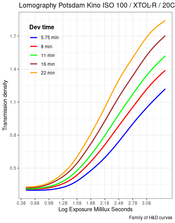aparat
Member
I started a project testing slow B&W films. To begin with, I chose the Ferrania P30 and ILFORD PAN F Plus. If you are interested in a particular slow film (ISO 50 or lower), please let me know. I will try to add it to the list.

I enjoyed working with both films. The PAN F Plus was a typical, nearly flawless Ilford product, but the Ferrania P30 surprised me. It comes beautifully packaged, in well-made boxes and high-quality cassettes. Additionally, each roll comes with a unique QR code. Ferrania says that "From now on, every roll of film we produce will come with a QR code that links to a secure database, making every roll completely unique!" More on this on the company's blog. Whether it is a useful feature or a gimmick, remains to be seen. Still, it's a novel idea in the film market. The film seems like a terrific product, at least superficially. Ferrania might have had some problems getting the project off the ground, but the company has remained fairly transparent about their process and engaged with the community.
Judging by the information provided by the manufacturers, Ferrania P30 and ILFORD PAN F Plus should have similar speed and, possibly, other characteristics. Let's see how they perform.
I ran my usual six-curve family test of the two films, targeting ISO 50 exposure. I processed the samples in XTOL (stock) for 2.5, 4, 5:45, 8, 11, and 16 minutes at 20C in a Jobo 1510 tank. I have detailed test reports available as twelve-page PDF documents, so please, let me know if you'd like me to upload it.
For now, let's look at the curve families and analysis summaries. In terms of film speed, the Ilford film is close to the ISO 50 box speed, but the Ferrania P30 appears to be much slower than the manufacturer's recommended EI 80, at around ISO 15. The speed discrepancy did not surprise me, but the response to development did. Ferrania needs very careful processing. In Kodak XTOL, the film needs less than 4 minutes of development at 20C to give "normal" contrast. I would not recommend using stock XTOL or D76 with this film, unless one wants a high-contrast negative. I think a low-contrast developer or a dilute standard developer are probably better choices, otherwise, you're running the risk of producing negatives that might be hard to print or scan.
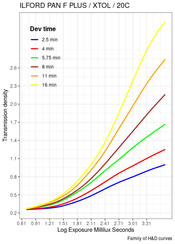
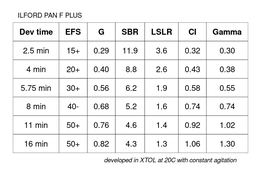
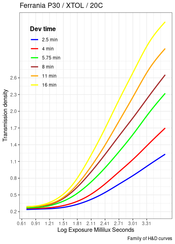
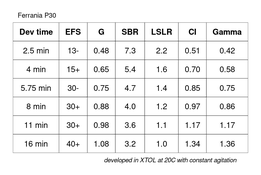

I enjoyed working with both films. The PAN F Plus was a typical, nearly flawless Ilford product, but the Ferrania P30 surprised me. It comes beautifully packaged, in well-made boxes and high-quality cassettes. Additionally, each roll comes with a unique QR code. Ferrania says that "From now on, every roll of film we produce will come with a QR code that links to a secure database, making every roll completely unique!" More on this on the company's blog. Whether it is a useful feature or a gimmick, remains to be seen. Still, it's a novel idea in the film market. The film seems like a terrific product, at least superficially. Ferrania might have had some problems getting the project off the ground, but the company has remained fairly transparent about their process and engaged with the community.
Judging by the information provided by the manufacturers, Ferrania P30 and ILFORD PAN F Plus should have similar speed and, possibly, other characteristics. Let's see how they perform.
I ran my usual six-curve family test of the two films, targeting ISO 50 exposure. I processed the samples in XTOL (stock) for 2.5, 4, 5:45, 8, 11, and 16 minutes at 20C in a Jobo 1510 tank. I have detailed test reports available as twelve-page PDF documents, so please, let me know if you'd like me to upload it.
For now, let's look at the curve families and analysis summaries. In terms of film speed, the Ilford film is close to the ISO 50 box speed, but the Ferrania P30 appears to be much slower than the manufacturer's recommended EI 80, at around ISO 15. The speed discrepancy did not surprise me, but the response to development did. Ferrania needs very careful processing. In Kodak XTOL, the film needs less than 4 minutes of development at 20C to give "normal" contrast. I would not recommend using stock XTOL or D76 with this film, unless one wants a high-contrast negative. I think a low-contrast developer or a dilute standard developer are probably better choices, otherwise, you're running the risk of producing negatives that might be hard to print or scan.













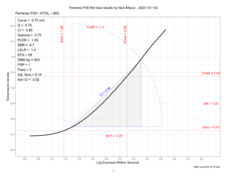



 .
.
